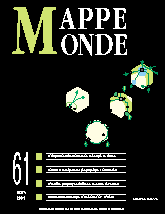

The worlds big cities: a cartographical study (1 fig.)
A statistical and cartographic analysis of the top rank of the world urban framework (million cities) leads us to confirm some hierarchies and to question others, and to examine the processes of urban diffusion on a global scale.
keyword: DIFFUSION, DISTRIBUTION, MILLION CITIES, URBANISATION
From Angelinopolis to Postmetropolis, or when the exception becomes the paradigm: a model for the global city? (2 fig.)
A graphic model of the global city has yet to be devised. It should emphasise spatial dynamics over structures. For a long time, Los Angeles was the exception to the archetype of the big city. Now, on the contrary, it seems likely to become the paradigm. This article proposes a reproduceable model inspired by the example of Los Angeles.
keyword: GLOBAL CITY, GRAPHIC MODEL, LOS ANGELES, PARADIGM, SPATIAL DYNAMICS
Jean-François Thémines.Cartographical practices and geographical discourse of secondary-school teachers. (6 fig.)
To analyse the cartographical practices in secondary geography teaching, this paper designs a model based on categories in semiotics and on the paradigm of spatial organisation. The model captures the epistemological positions of the teachers: distinct types of ordering of the world coexist in geography teaching, with/through maps and graphical models.
keyword: CARTOGRAPHICAL LANGUAGE, EDUCATION, GEOGRAPHICAL ORDERING, SECONDARY TEACHING, SIGN SYSTEM
Kamal Serrhini. The quantitative integration of landscape in planning the route of a linear development. (1 fig.)
The need for including “systematically” the landscape factor into the design of major planning projects (TGV, motorway) is growing increasingly important.
keyword: LANDSCAPE, LAYOUT OF TGV LINE, MULTI-CRITERIA AID TO DECISION MAKING, QUANTITATIVE EVALUATION
New spaces in South America: the Paraguayo-Brazilian border. (3 fig.)
In easternmost Paraguay, Brazilian pioneers have introduced original spatial organisation. This “Braziguayan” area is no longer strictly Paraguayan, but it cannot be considered as the mere western extension of patterns prevailing in southern Brazil either. This area, which was recently on the edge of human settlement, has become a contact zone between local, national, macro-regional and even global spatial structures.
keyword: BRAZIL, GLOBALISATION, INTERNATIONAL MIGRATION, PARAGUAY, PIONEER FRINGE, SPATIAL DYNAMICS
Socio-spatial organisation of the old city of Kathmandu at the end of the 20th century. (2 fig.)
How has Hinduism, through its ancient treatises on the city and cast system, served as a basis for the construction of many cities? This paper takes the example of Kathmandu, the modern capital of Nepal, and a royal Hindu city since at least the 14th century. It discusses the links between macrocosm and microcosm, social organisation and spatial distribution, which are underpinned by the observance of certain principles intended to maintain harmony.
keyword: CAST SYSTEM, KATHMANDU, NEPAL, SPATIAL ORGANISATION, TREATISES ON THE CITY
The exceptional geographical distribution of Vermeer paintings. (3 fig.)
The work of Johannes Vermeer, consisting of 35 paintings, is distributed across only seven countries. Nearly 40 % of the paintings are located on the East Coast of the United States. This is an exceptional geographical distribution for a no less exceptional painter, the (re)discovery of whom coincided with the assertion of the United States economic power.
keyword: CIRCULATION, JOHANNES VERMEER, MAJOR POWERS, PAINTING, SPATIAL DISTRIBUTION, UNITED STATES
Maximilien Piquant, Motorways and storage in south-eastern France. (3 fig.)
In south-eastern France, 80% of storage activities are located within 20 km of a motorway junction. However, the mechanism of location is not limited to a simple, systematic gravitation around the motorway. This attraction is combined with a strong draining effect caused by urban areas.
keyword: MOTORWAY, SOUTH-EASTERN FRANCE, STORAGE ACTIVITIES, STRUCTURING EFFECTS, TRANSPORT
Roger Brunet.Regional undevelopment: energy in France. (3 fig.)
France has seen periods of fairly broad diffusion of energy resources. The recent trend has been towards reconcentration on axes that are already the most overloaded in the country, increasing the risk of transport accidents and imbalances.
keyword: ENERGY, FRANCE, NATURAL GAS, OIL, REGIONAL DEVELOPMENT
Book reviews (Roger Brunet, Joël Charre, Céline Rozenblat, Pierre Usselmann)
Mappemonde 4/00![]()
![]() Mappemonde 2/01
Mappemonde 2/01
For subscribe or buy this issue: BELIN
Last modified: March 14, 2001